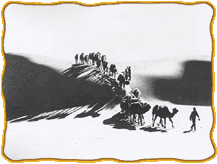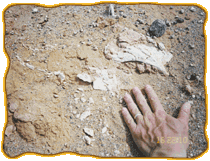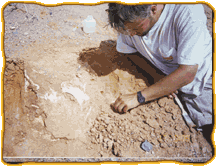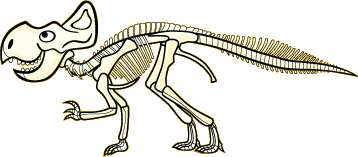


DEENA: So what happened? One day you're happily munching away on thick, tough plants, the next you're history?
PROTO ANDY: Some paleontologists think one of those nasty Gobi "sand avalanches" got me. Heavy rainstorms can cause the sand to flow like a mud slide. It could have been worse. Ok, I was killed. That's the bad news. The good news is that the sand buried me before other animals could devour me. And now, I help build scientific knowledge!
DEENA: How did you go from being a "Gobi sandwich" to a fossil ?
PROTO ANDY: After I was buried, my body decomposed very slowly underground.
DEENA: Yuck!
PROTO ANDY: Happens to the best of us. Eventually, all the fleshy parts of my body were gone. Over millions of years, water in the nearby rocks surrounded my bones. Some of the minerals in the water replaced parts of my bones. Then I became a fossil. I was lucky that my bones were not distorted by all the heat and pressure.

DEENA: Your bones were underground for 80 million years. How did the paleontologists find you?
PROTO ANDY: They just ran around the Gobi shouting, "Here, Proto-Proto! Here, Proto-Proto!"...Just kidding.

DEENA: Come on, I'm serious. What happened?
PROTO ANDY: In the Gobi, the paleontologists know to look for fossils in sandstone, a kind of sedimentary rock . Because of erosion — forces like rain, hail and wind — some of my bones stuck out of the ground a bit. Scientists knew that once they found my exposed foot, the chances were good that the rest of me was buried not far away.




 Biodiversity
Biodiversity
 Brain
Brain
 Genetics
Genetics
 Marine BiOLogy
Marine BiOLogy
 MicrobiOLogy
MicrobiOLogy
 PaleontOLogy
PaleontOLogy
 ZoOLogy
ZoOLogy
 AnthropOLogy
AnthropOLogy
 ArchaeOLogy
ArchaeOLogy
 Astronomy
Astronomy
 Climate Change
Climate Change
 Earth
Earth
 Physics
Physics
 Water
Water







